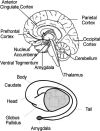Behavioral perspectives on the neuroscience of drug addiction
- PMID: 16596985
- PMCID: PMC1389786
- DOI: 10.1901/jeab.2005.101-04
Behavioral perspectives on the neuroscience of drug addiction
Abstract
Neuroscientific approaches to drug addiction traditionally have been based on the premise that addiction is a process that results from brain changes that in turn result from chronic administration of drugs of abuse. An alternative approach views drug addiction as a behavioral disorder in which drugs function as preeminent reinforcers. Although there is a fundamental discrepancy between these two approaches, the emerging neuroscience of reinforcement and choice behavior eventually may shed light on the brain mechanisms involved in excessive drug use. Behavioral scientists could assist in this understanding by devoting more attention to the assessment of differences in the reinforcing strength of drugs and by attempting to develop and validate behavioral models of addiction.
Figures
Similar articles
-
CSPT circuitry in affective disorders.Biol Psychiatry. 1994 Aug 1;36(3):208-9. doi: 10.1016/0006-3223(94)91231-9. Biol Psychiatry. 1994. PMID: 7948462 No abstract available.
-
The role of dopamine in drug abuse viewed from the perspective of its role in motivation.Drug Alcohol Depend. 1995 May;38(2):95-137. doi: 10.1016/0376-8716(95)01118-i. Drug Alcohol Depend. 1995. PMID: 7671769 Review.
-
The role of the striatopallidal and extended amygdala systems in drug addiction.Ann N Y Acad Sci. 1999 Jun 29;877:445-60. doi: 10.1111/j.1749-6632.1999.tb09282.x. Ann N Y Acad Sci. 1999. PMID: 10415664 Review.
-
[Neuroscientific basic in addiction].Ther Umsch. 2014 Oct;71(10):579-83. doi: 10.1024/0040-5930/a000556. Ther Umsch. 2014. PMID: 25257111 Review. German.
-
Dopamine, reinforcement learning, and addiction.Pharmacopsychiatry. 2009 May;42 Suppl 1:S56-65. doi: 10.1055/s-0028-1124107. Epub 2009 May 11. Pharmacopsychiatry. 2009. PMID: 19434556 Review.
Cited by
-
Impact of MAOA Gene Polymorphism on the Efficacy of Antidepressant Treatment and Craving Severity for Betel Quid Use Disorder.Int J Mol Sci. 2024 Aug 25;25(17):9221. doi: 10.3390/ijms25179221. Int J Mol Sci. 2024. PMID: 39273170 Free PMC article. Clinical Trial.
-
Is Illicit Substance Use Gender-Specific? The Basic Points of Mental and Health Disorders.Toxics. 2022 Jun 22;10(7):344. doi: 10.3390/toxics10070344. Toxics. 2022. PMID: 35878250 Free PMC article. Review.
-
Crystal Clear: Metal-Organic Frameworks Pioneering the Path to Future Drug Detox.ACS Appl Mater Interfaces. 2024 Jun 12;16(23):29657-29671. doi: 10.1021/acsami.4c02450. Epub 2024 May 30. ACS Appl Mater Interfaces. 2024. PMID: 38815127 Free PMC article.
-
Simultaneous expression of cocaine-induced behavioral sensitization and conditioned place preference in individual rats.Brain Res. 2008 Jun 5;1213:57-68. doi: 10.1016/j.brainres.2008.03.054. Epub 2008 Apr 8. Brain Res. 2008. PMID: 18455710 Free PMC article.
-
Competition between novelty and cocaine conditioned reward is sensitive to drug dose and retention interval.Behav Neurosci. 2010 Feb;124(1):141-151. doi: 10.1037/a0018226. Behav Neurosci. 2010. PMID: 20141289 Free PMC article.
References
-
- Ahmed S.H, Koob G.F. Transition from moderate to excessive drug intake: Change in hedonic set point. Science. 1998;282:298–300. - PubMed
-
- Ahmed S.H, Walker J.R, Koob G.F. Persistent increase in the motivation to take heroin in rats with a history of drug escalation. Neuropsychopharmacology. 2000;22:413–421. - PubMed
-
- Alexander G.E, DeLong M.R, Strick P.L. Parallel organization of functionally segregated circuits linking basal ganglia and cortex. Annual Review of Neuroscience. 1986;9:357–381. - PubMed
-
- Alheid G.F. Extended amygdala and basal forebrain. Annals of the New York Academy of Science. 2003;985:185–205. - PubMed
-
- Bardo M.T, Bevins R.A. Conditioned place preference: what does it add to our preclinical understanding of drug reward? Psychopharmacology. 2000;153:31–43. - PubMed


